Increasingly recognized today for its ecological, cultural, aesthetic, and economic value, urban lumber is a product of opportunity created out of a necessity sometimes caused by calamity. When a passing windstorm, tree-killing epidemic, or just the ravages of time or progress cause trees to be removed, they may attain an afterlife within the community as urban lumber.
Simply put, urban lumber is wood sawn from trees grown within the very community where it finds its final use in construction and woodworking projects. More broadly, urban lumber can be described as a social movement that started locally but went national and became an emerging business segment.
In some sense, building or woodworking with urban lumber is like buying food at a farmers’ market. It is a way to act locally while connecting to the living processes that provide us with our human needs and wants.
Urban forests recognized as they were dwindling
Consider that even a small municipality may have thousands of trees within its city limits and that these comprise a uniquely urban forest. This is a dynamic tree population, as in any forest, and eventually all trees must meet their demise. Sometimes, as in the early 2000s when the invasive emerald ash borer unleashed a devastating epidemic that swept across North America, the numbers of trees needing to be cut are immense.
In the face of certainty at the time that all of the many ash trees in Madison, Wisconsin’s Schenk–Atwood neighborhood would be dying, community members and others faced the question of what to do about it. It began with mapping out all that neighborhood’s trees that would be lost due to ash borer, then broadened into a discussion of what to do with all the wood to be removed, and eventually grew into what is today the Urban Wood Network (https://urbanwoodnetwork.org), a nationwide organization of arborists, sawyers, woodworkers and others dedicated to putting urban trees “to their highest and best uses to maximize their economic, environmental, and societal benefits for people in urban areas and beyond.”
Typically, those best uses are expressed in artisan-quality furniture, community buildings and infrastructure, and treasured decor in family homes and local businesses. Although difficult to measure, this presumably contributes to a stronger public connection to and appreciation for trees in the urban living environment. It seems likely that the emerald ash borer catastrophe also served to draw much-deserved attention to the entire field known as urban forestry.
Urban forests are unique
Just as urban forests are distinctive, so, too, can be the sawn wood that they produce. When loggers cut trees in commercial forests, they haul out the nice straight logs but generally leave the potentially most interesting pieces of wood behind on the forest floor. That’s not likely to happen when dead, dying, damaged, or inconveniently situated trees are taken down in cities like Madison and the nearby smaller city of Stoughton, where community members take strong interest in trees and their end-of-life fates.
Urban wood is sawn from trees that once lined a city’s streets, providing daily stopping places for generations of neighborhood dogs and sequestering greenhouse gases exhausted through thousands of rush hours.
Unique wood slabs and other cuts bearing the shapes, textures and colors of knots, galls, cracks, crotches, and sap staining that never make it out of commercial sawmills and into the standard distribution channels may be prized attributes in urban lumber.
Moreover, urban wood can be a repository of local culture and history. It is sawn from trees that once lined a city’s streets, providing daily stopping places for generations of neighborhood dogs and sequestering greenhouse gases exhausted through thousands of rush hours. Urban lumber could be from a cherished oak that shaded countless picnics in a city park or a big old maple with a rope swing at the corner of a city block that delighted all the neighborhood kids. It might also be from a local resident’s backyard – perhaps an ancient apple tree, spiked with the nails from each of several generations’ treehouses.
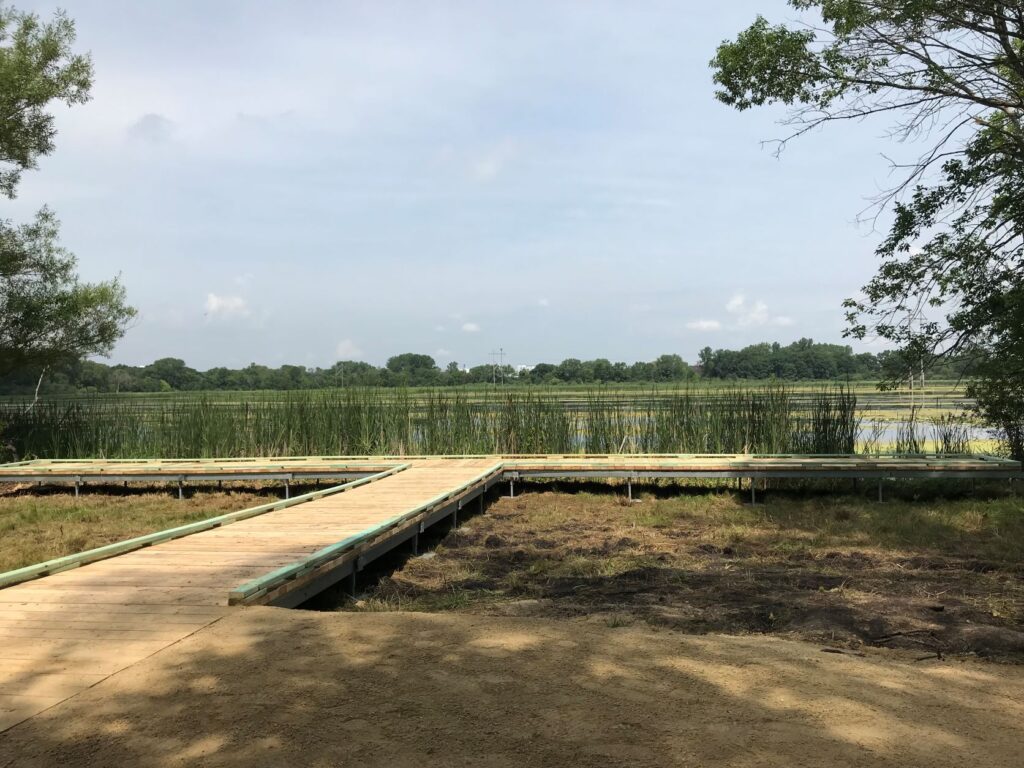
A boardwalk in Stoughton, Wisconsin, built from locally salvaged urban lumber.
Contributing to the local economy
Paul Morrison’s Madison-area business, The Wood Cycle (www.thewoodcycle.com) was launched in the late 1990s, just before the ash borer was first discovered cutting what quickly became a broad swath through the Midwest’s ash tree population. Today his custom sawmill and furniture business, situated on a repurposed family farmstead, turns out custom and unique wooden items, as well as live-edge wood slabs, flooring, and other cuts originating from trees formerly rooted in Madison and surrounding communities.
Unique wood slabs and other cuts bearing the shapes, textures and colors of knots, galls, cracks, crotches, and sap staining may be prized attributes in urban lumber.
Some of that wood is retailed to woodworkers, homeowners, and builders at the local Habitat for Humanity ReStore, run by the highly respected charity Habitat for Humanity that supports homebuilding for those who could not otherwise afford it. Paul says the urban lumber is in strong demand at the ReStore.
A lifelong woodworking enthusiast and for two decades an engineer at Wisconsin’s Department of Agriculture, Trade and Consumer Protection, Paul took an early interest in the community activity in the Schenk–Atwood neighborhood and was a founding member of Wisconsin Urban Wood (now the Urban Wood Network). The Wood Cycle was something quite unique when it began, Paul recalls, “an entirely new breed of custom woodworking.” But today, he explains, urban lumber and woodworking operations like his represent “a business model that is emerging from coast to coast” and his firm “is just one business in a rapidly growing movement.”
In addition to the emerald ash borer crisis and what he hopes is a growing appreciation for trees and products crafted from them, Paul explains that a relatively simple technological development has fostered the urban lumber movement. In decades and centuries past, sawmills operated large circular saws. Those sawyers (the traditional name for a sawmill operator) were not interested in anything other than long and straight logs from woodlots and wild forests. Urban trees were likely to harbor nails, embedded cable, wire, and the like that would smash a costly circular saw and send shrapnel-like objects shooting across the work space. Less costly – and even portable – bandsaw mills have reduced those risks and made milling more accessible.
The technology today existing and the artisanal business model, Paul relates, allow him and his associates to evaluate each log and to make cuts that bring out the unique “character” of the wood in every case. After all, they are not working with trees that were “harvested” in the usual sense of the word. Oftentimes, these were beloved trees on a family property or which graced a neighborhood for so long as anybody remembers. Their very imperfections make them precious and add character when carried over into a table, lamp, stairway, or other custom piece.
Indeed, Paul, who prefers the term “urban wood,” defines it as “lumber produced from trees that were removed for reasons other than harvest of their lumber.” Urban wood also has been described as “lumber with a zip code,” to use the words of Edith Makra, who was then chairperson of the Illinois Emerald Ash Borer Wood Utilization Team when she used that term in speaking at a 2012 conference on urban forestry. Perhaps the main reason for urban lumber’s rising popularity, Makra had observed, is that it embodies local history and culture while softening the blow of losing trees cherished by families and the community.
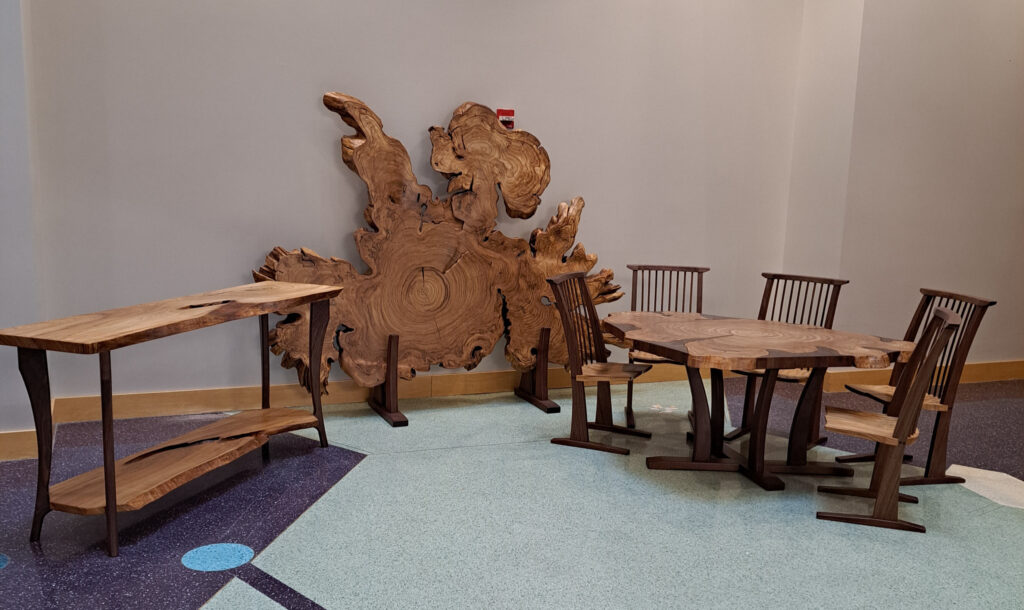
The University of Wisconsin–Madison recently lost its largest elm tree to Dutch Elm disease. Now, the tree lives on as a table and chairs on campus.
Stoughton has its Wood Utilization Program
Down the road from Madison, in the city of Stoughton (population ca 13,000), city forester John Kemppainen is responsible for a population of nearly 6,000 trees in public spaces – and even more if one includes the city’s natural areas. Stoughton has had its “Wood Utilization Program” for about a decade. It was started by his predecessor before John joined the city in 2017. Like Paul, John is on the steering committee of the Urban Wood Network’s Wisconsin chapter.
John is the sole employee in Stoughton’s urban forestry office, so professionals from the Streets and Parks Maintenance divisions support his work and there is also community involvement. Of course, he notes, the city employees only remove trees that need to be taken down or cleared away because of storm damage, disease, or another good reason. The program is not run to generate a profit, but John says he’s always looking to salvage good logs. The city maintains a small log yard, and from time to time he calls in a sawyer with a portable mill to cut the logs. Moreover, a local manufacturing company has helped to design, build, and donate a solar kiln for drying the cut lumber.
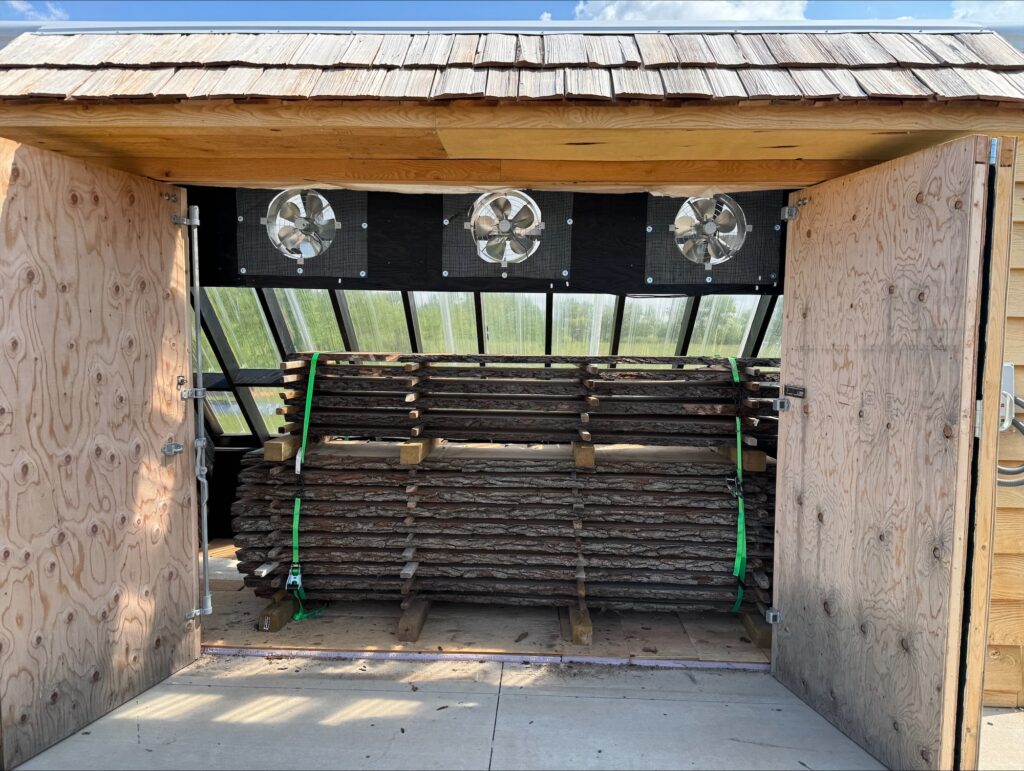
Lumber drying in a solar kiln designed, built and donated by a local company in Stoughton, Wisconsin.
Some of the logs are cut into big slabs to create tables, benches, and the like for use in the community. It is a source of civic pride that certain public works are constructed utilizing home-grown lumber. Then, too, from time to time, John and members of the local tree commission will run an ad hoc lumber sale that is open to the public. “We’ll sit around for an afternoon and sell lumber to residents,” he says, “and those kinds of public outreach events have been good.”
“My most valued partner right now is a woodworker maker space that opened here in town about two or three years ago. They buy quite a bit from me,” John relates. “They’ve got good demand from their members. So, they tell me, hey, we’re looking for this and this and I keep my eye open for it, and whenever I can I supply things to their specs.” (A maker space is a membership-based woodworking shop where members share tools and work space. This one also has a storefront component and some of the members offer their works for sale.)
Benefits are real but difficult to quantify
Urban lumber embodies a number of positive aspects. “You can’t separate the social aspects from the environmental aspects and the economic aspects as well,” Paul Morrison remarks. “I mean, they’re all so tied together, and it comes down to those same core things, that these are trees that are the most local and most of the wood they provide is going to be used within that same urban environment.” That means the consumption of fossil fuels and other energy sources to prepare and transport the lumber are minimal. Moreover, the wood’s processing and use provide jobs and support the local economy.
Wood that is produced close to home also is not likely to bring a pest or disease into the community from afar. The fact is, of course, that today the lumber business is global, and the movement of wood also brings the spreading of disease. For example, emerald ash borer is thought to have arrived to the U.S. from China around the turn of the 21st century while harboring in the wood used to produce shipping crates. In the 20th century, Dutch elm disease had come to the U.S. from the Netherlands, probably in a shipment of logs, but it, too, had originated in Asia. (Ironically, many of those ash trees cut in the 21st century had been planted to replace elm trees killed in the 20th century.)
Then, too, wood used as a building material or to produce quality products that might otherwise be made of plastic, metal, or concrete serves to sequester carbon rather than emit it. The wood that goes into a quality product, such as a piece of furniture, may be “out of the carbon cycle for 20, 30, 100 years,” Paul remarks.
Well, okay, but can this really be significant? Folks at the Urban Wood Network say yes. According to information on the Network’s website, every year in the United States, municipalities chip, burn, or landfill about 12.7 million metric tons of urban logs that could be processed into quality lumber and durable wood products. If just 20% of that were to be made into those long-lasting products, the Network asserts, “the carbon offset would be equivalent to planting approximately 154 million trees and growing them for 10 years.”
“Urban forestry absolutely can make a huge impact on climate change and carbon sequestration. You know, a large mature tree holds onto a significant amount of carbon and produces a substantial amount of oxygen and will divert and uptake hundreds of gallons of water every single day.”
Even more difficult to quantify is the value that urban wood may bring by fostering public appreciation for the connections between beautiful objects of wood, an abundance of trees in their communities, and a healthier environment. In short, this is the value of urban forests and forestry generally.
“Urban forestry absolutely can make a huge impact on climate change and carbon sequestration,” John Kemppainen assures. “You know, a large mature tree holds onto a significant amount of carbon and produces a substantial amount of oxygen and will divert and uptake hundreds of gallons of water every single day. So, stormwater and carbon sequestration absolutely are impacted by urban forestry.”
Stories and history preserved, too
For Paul, a storyteller in his own right (and author of the book Tree to Table: Emergence of the Urban Wood Movement), one of the most rewarding aspects of his work is to participate in preserving local and family history and folklore. Many is the storied and beloved tree that has passed through his sawmill, not to be forgotten but to be remembered. He tells the story, for example, of a tree at the University of Wisconsin–Madison’s student union associated with Aldo Leopold, the pioneering environmentalist who was a professor at the school and author of A Sand Country Almanac.
(Leopold is known for originating and defining his “land ethic.” “A thing is right,” Leopold wrote, “when it tends to preserve the integrity, stability, and beauty of the biotic community. It is wrong when it tends otherwise.”)
“That particular tree, so the story goes, and again, sometimes it’s storytelling, sometimes it’s actual history, but the story goes that Aldo Leopold, when he was on the University faculty, fought to protect this specific oak tree when the Union Theater was added to the building back in the early 1900s,” Paul relates. When the tree finally succumbed to age a few years ago, it was deemed too important to Madison history (or perhaps urban legend) to be disposed of and so the logs were sawn and the wood incorporated into the building.
Then there’s the monkey chronicle… On 4 August 1960, 38 monkeys escaped from Madison’s Vilas Park Zoo (a documented true story) and set out to explore the surrounding neighborhood. A 7-year-old boy woke up in the morning, looked out the window toward his tree fort in the backyard to see that it had been occupied by arboreal primates. Of course, he went and informed his sleeping dad about it, then was told he was dreaming and should go back to bed. As it turns out, there were indeed monkeys in the treehouse, and it took zookeepers a good bit of effort and convincing to get them back where they’d come from.
Well, four decades later, that tree had to come down. The bearer of the monkey news kept some wood from the tree, his brother had a table made from it, and the current owners of the house have a dining set and desk produced from the monkey tree.

A dining table crafted from a storied oak tree which came to be known as “the monkey tree” after it became temporary refuge for primates escaping from Madison’s zoo.
Not every beneficial thing can be fully quantified, and that is probably true of urban lumber and even of urban forests generally, but it just makes good sense that, to use Leopold’s words, utilizing locally grown resources within the community while caring for their replacements “tends to preserve the integrity, stability, and beauty of the biotic community.”

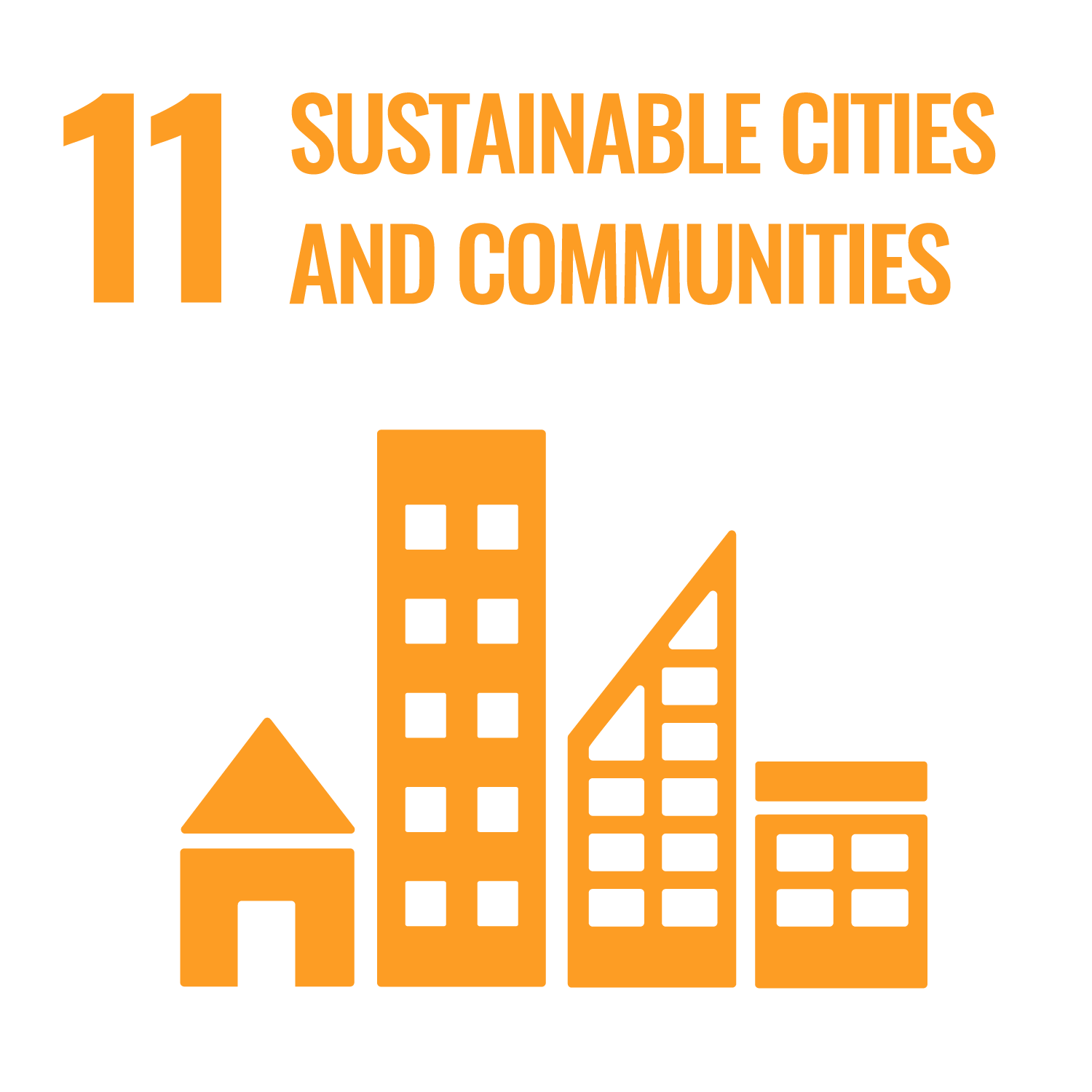

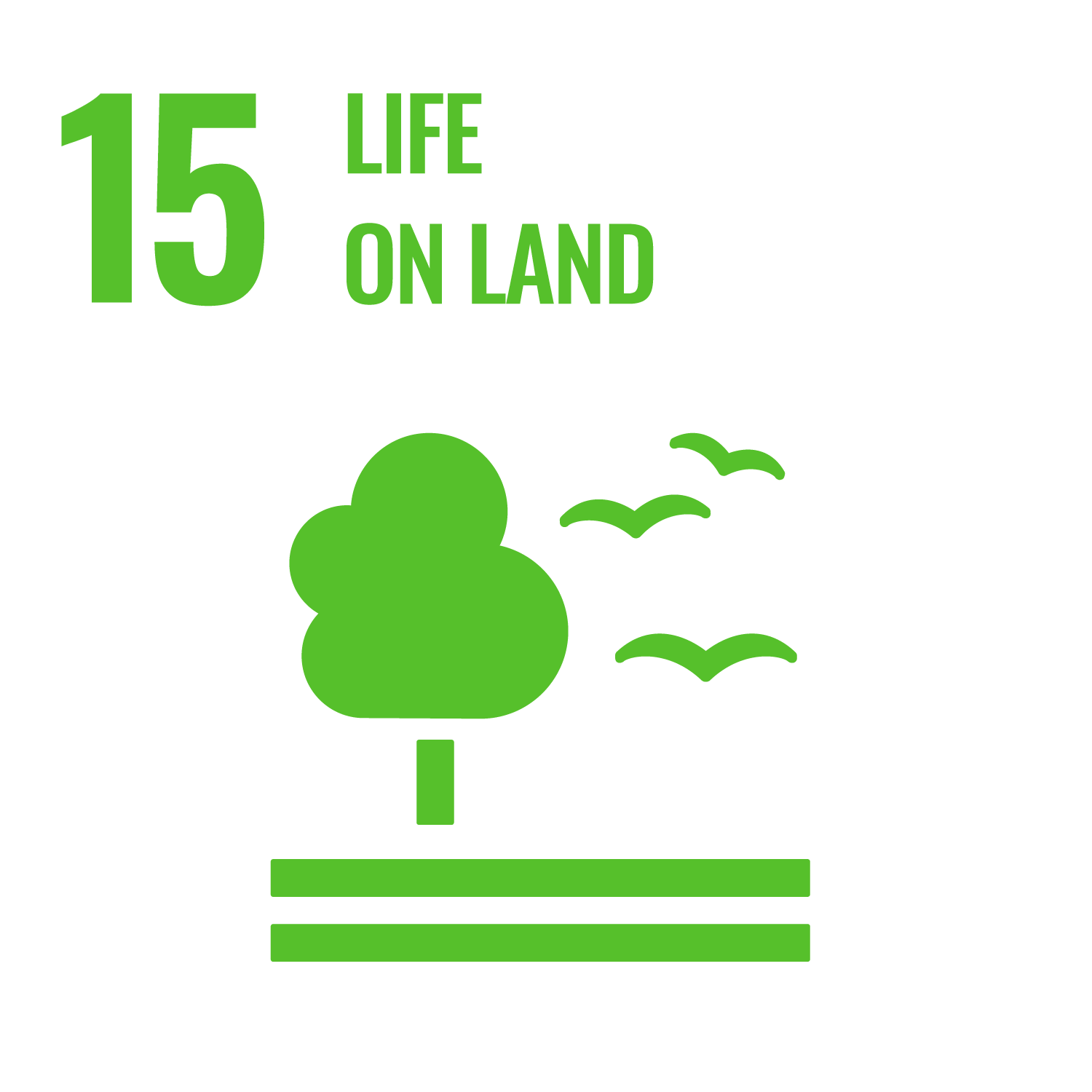
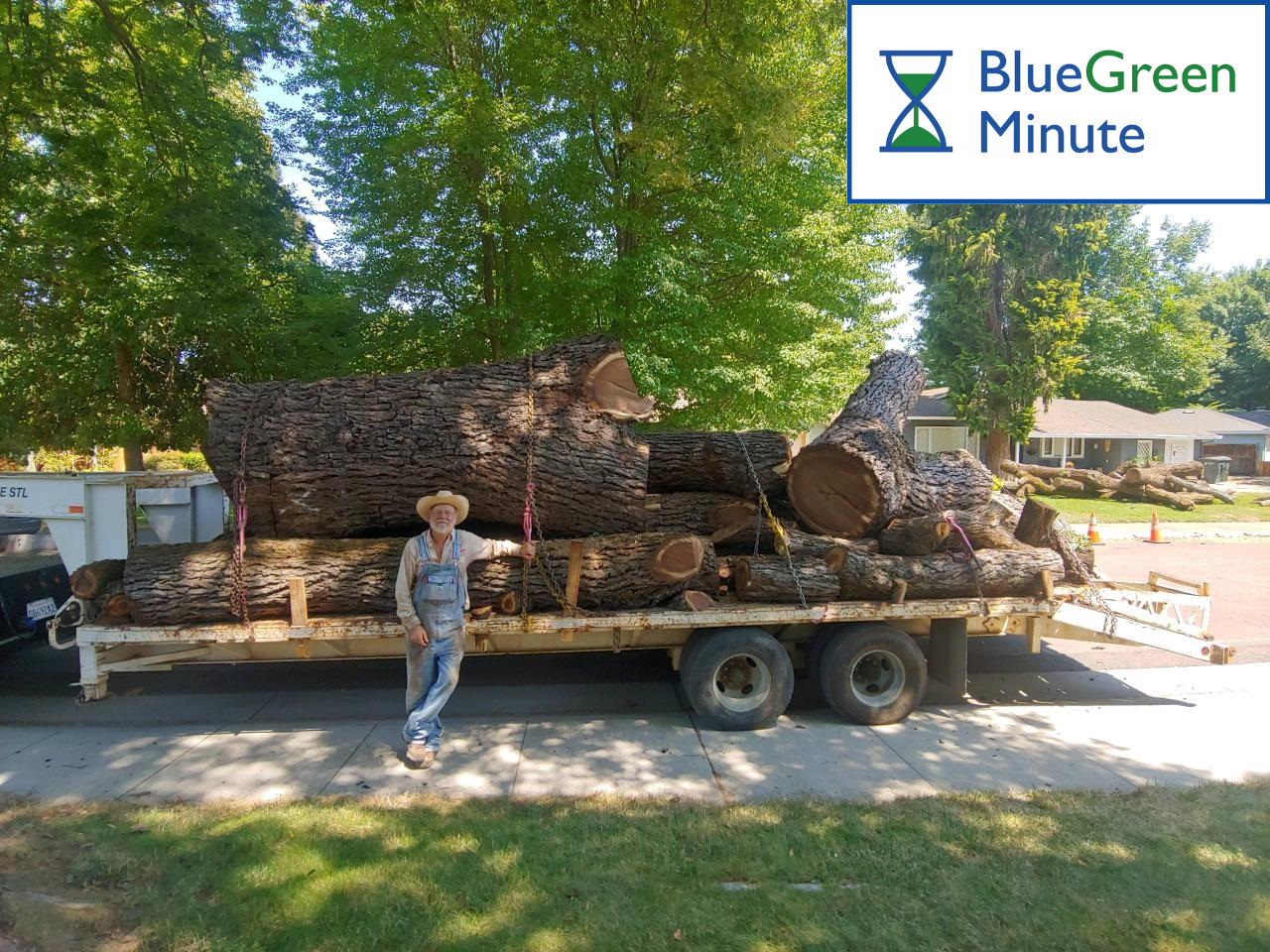
2 Responses
Good idea. Maybe the UW-Madison gets rid of their trees this way instead of burying them like they did in the late 1970’s when I went to school there!!!
It’s interesting, Bruce, that you point out the University of Wisconsin-Madison used to bury the trees. We hope they don’t do that anymore! We’ve heard tell that the dumping of urban wood into landfills may have been a major motivation for emergence of the Urban Wood movement in the Western states more so than was Emerald Ash Borer. We are going to explore that further and hope to write more about that in Channel BlueGreen in the near future. Thanks for commenting!